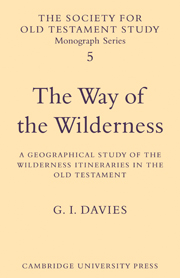Book contents
- Frontmatter
- Contents
- Preface
- Abbreviations
- Maps
- 1 Introduction
- 2 Jewish interpretations in Greek
- 3 Jewish interpretations in Hebrew and Aramaic
- 4 Christian interpretations
- 5 Arabic interpretations
- 6 Behind the traditions
- 7 Key points on the routes
- 8 Routes in the Sinai Peninsula
- 9 Identification of the routes described
- Notes to the text
- Bibliography and Author Index
- Indexes
4 - Christian interpretations
Published online by Cambridge University Press: 04 August 2010
- Frontmatter
- Contents
- Preface
- Abbreviations
- Maps
- 1 Introduction
- 2 Jewish interpretations in Greek
- 3 Jewish interpretations in Hebrew and Aramaic
- 4 Christian interpretations
- 5 Arabic interpretations
- 6 Behind the traditions
- 7 Key points on the routes
- 8 Routes in the Sinai Peninsula
- 9 Identification of the routes described
- Notes to the text
- Bibliography and Author Index
- Indexes
Summary
In surviving Christian literature of the first three centuries AD there is surprisingly little evidence of any acquaintance with a geographical interpretation of the wilderness itineraries, despite the fact that by this time, as we have seen, a number of identifications were current in Jewish circles. The ‘sea’ of Exodus was of course equated with the Red Sea (cf. Acts 7: 36; Heb. 11: 29), following the rendering given in LXX. Other than this only indications of the location of Mount Sinai (and vague ones at that) are found. Paul located it in ‘Arabia’ (Gal. 4: 25), but in view of the wide area covered by this term, which included the Sinai peninsula as well as Arabia proper, we at any rate cannot be sure where Paul thought it was, even if he himself was acquainted with a specific local tradition. A third-century anti-Jewish tract ascribed to Cyprian put Mount Sinai in Palestine, which was at that time a shortened form of the name of the Roman province of Syria Palaestina, whose southern border was in the northern Negeb. The inclusion of the Sinai peninsula in ‘Palestine’ was only possible after the reorganisation of the area at about 300 AD which added most of what had hitherto been Arabia Petraea to Palestine, and seems to be first attested in the sixth century. This could be taken to mean that Pseudo-Cyprian knew a tradition that Mount Sinai was in the hill country in the south of Palestine proper.
- Type
- Chapter
- Information
- The Way of the WildernessA Geographical Study of the Wilderness Itineraries in the Old Testament, pp. 30 - 48Publisher: Cambridge University PressPrint publication year: 1979



